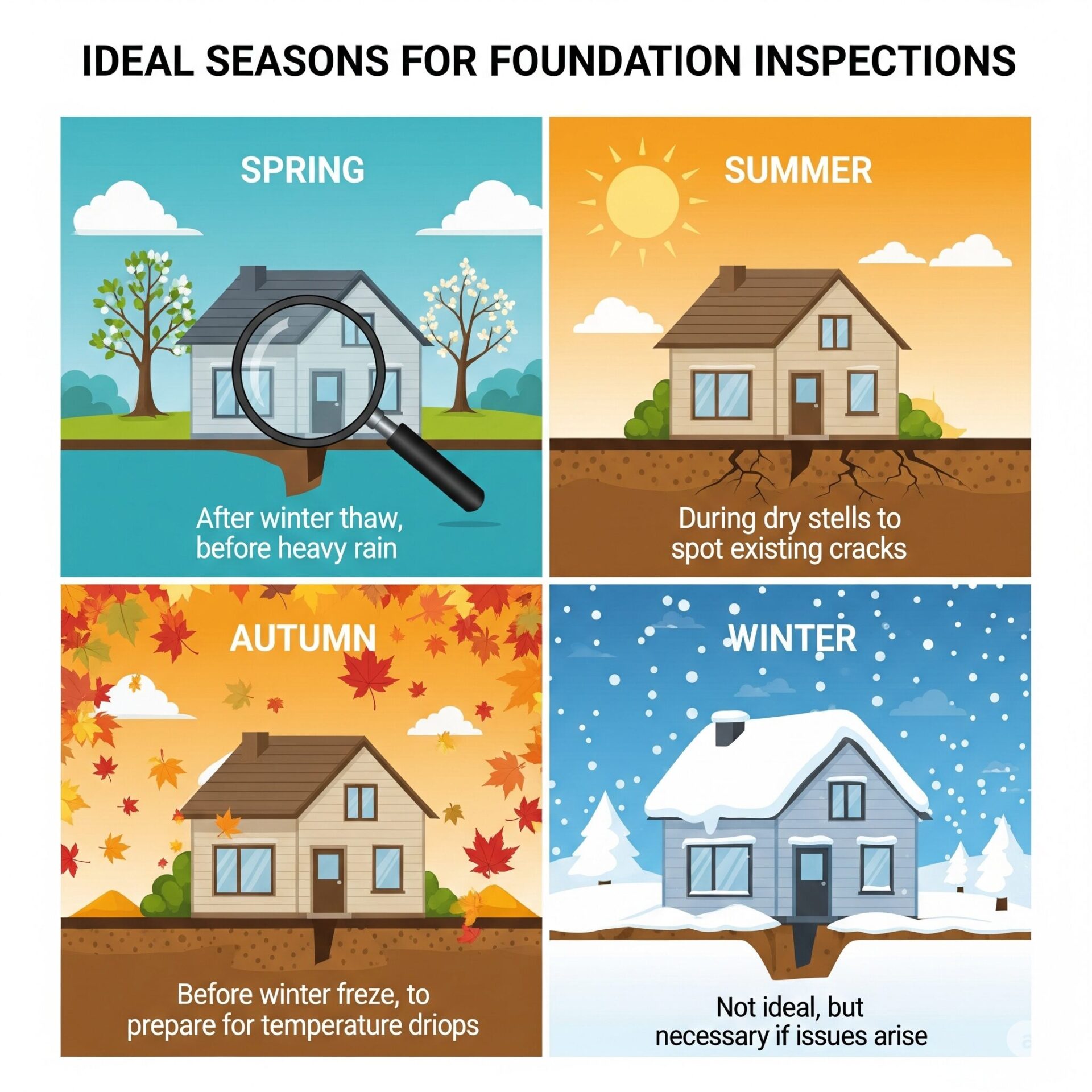The foundation is the base on which your homes stand. As crucial as it is, many homeowners overlook its maintenance until noticeable issues arise. A foundation inspection can help identify problems before they escalate, saving money and ensuring safety. So, when is the right time for a foundation inspection? Let’s delve into the topic.
You might like: The Hidden Value of Foundation Inspections and Repairs for Your Home
What is a Foundation Inspection?
A home foundation inspection is a crucial first step in evaluating the structural stability of your property. Its main goal is to identify potential foundation problems and determine their underlying causes. During the inspection, a foundation repair service expert will assess signs such as wall cracks, uneven floors, or misaligned doors, common indicators that your foundation may be shifting or settling.
Who Conducts Foundation Inspections?
It is not a task for the average homeowner. Professionals, often structural engineers or specialists in foundation repair, bring the requisite knowledge and equipment for the job. Their training allows them to spot issues and suggest potential remedies, offering peace of mind to homeowners.
Key Signs That Suggest an Immediate Inspection:
There are clear indicators that your foundation may be in trouble. If you find any of these or suspect a possible foundation shift, it is wise to contact a home foundation inspection near me and get the property thoroughly inspected.
Cracks:
While small hairline cracks in walls can be a natural settling process, larger fissures, especially in the foundation itself, are a red flag.
Sticking Doors or Windows:
If your doors or windows have become challenging to open or close, it might be due to a shifting foundation.
Uneven or Sloping Floors:
Notice a tilt in your living room? It’s not just an optical illusion; it might be a foundation issue.
Gaps:
Spaces appearing between walls and the ceiling or floor, or between windows and the wall.
What Does an Inspection Involve?
An expert from R.L. NELSON Foundation Solutions will carefully look around your house to understand if there are any possible signs of foundation damage. The visit includes a number of steps from the home foundation inspection checklist by R.L. NELSON Foundation Solutions which includes technical and detailed surveys of the location.
Visual Assessment:
Inspectors start by examining visible parts of the foundation for signs like cracks, displacements, or decay. This includes carefully inspecting the walls, windows and surfaces to check any changes. Then they examine the exterior walls and land to identify any changes.
Functionality Checks:
They’ll test doors and windows to ensure they operate smoothly, a potential indicator of foundation movement. If they detect a slight jam in them, they move on to the next step which is a detailed analysis involving various tools.
Detailed Analysis:
Using tools, inspectors might measure the depth and width of cracks or check for moisture content. A crack which appears wide on one end and narrow on the other could possibly be problematic as it indicates towards the foundation problem. However, the steps move onto the next step before making a final decision.
Surrounding Examination:
The immediate environment, like soil quality and drainage patterns, is scrutinized. The inspectors carefully examine the possible reasons for the damage before deciding to ensure they have all the necessary information. This also includes asking some questions from the residents of the house to understand the changes they have seen over the past few days.
Dangers of Overlooking the Foundation
The possible dangers of overlooking a possible foundation shift could be risky. It may lead to severe property damage as well as risks the life of the residents too.
Safety Concerns:
Structural issues could escalate, making the building unsafe. This may lead to weakened pillars and roofs, which may fall on someone without any prior warning.
Financial Strain:
Early detection can save considerable repair costs down the line. However, as time passes, the cost of fixing the shift increases due to the complexity of work.
Property Value:
A home with a compromised foundation can see its market value plummet. This may cause major losses in the long run.
After the Inspection: The Report
Once the inspection concludes, homeowners typically receive a detailed report from R.L. NELSON Foundation Solutions. This document consists of points noted by the inspector, the solutions provided, and an estimated cost of the repairs.
Lists Findings:
The findings from the inspector will be detailed irrespective of their severity. This includes all the major and minor issues noted during the visit. However, it is not necessary that all the points are the reason for the foundation shift.
Offers Recommendations:
The report will suggest both immediate remedies and long-term maintenance tips. This will help you understand the risk and durability of your property.
Provides Estimates:
While not a quotation, it can give homeowners a figure of potential repair costs. In this way, you will be able to figure out your budget and bring the cost down by getting the repair done in time.

Ideal Times of Year for Foundation Inspections
Spring:
After heavy rains or snowmelt, soil shifts can expose foundation issues. Spring is a great time to assess how your home has weathered winter.
Summer:
Extreme heat can dry and contract the soil, especially in clay-rich areas, leading to foundation settlement.
Fall:
Before winter sets in, a foundation check ensures your home is ready to face freeze-thaw cycles and shifting soil.
Winter:
Though less common, winter inspections may be necessary if you notice issues like cracked walls, moisture intrusion, or cold drafts.
Tip: In regions with expansive clay soil (like Texas ), summer and fall are critical times for inspection due to soil movement.
When Should One Get a Foundation Inspection?
Before Buying a Property:
Hiring an expert to evaluate your property before purchasing is important to ensure your investment is sound. This can also help you save some pennies if the property requires some repairs.
After Natural Disasters:
Earthquakes, floods, or heavy storms might affect foundation integrity. Thus, it is vital to get your property inspected after any natural calamity. This may save you a big amount before it is too late.
Before Major Renovations
Adding a second story? Expanding your kitchen? Make sure your foundation can handle the extra load before remodeling.
Regularly:
Even without obvious signs, a periodic inspection can serve as a preventive measure. In this way, you will be able to detect any serious issues before it may even start causing any trouble. An early repair will cost you way less than a repair later in life.
Final Thoughts: Don’t Wait Until It’s Too Late
Foundation issues rarely fix themselves and the longer they’re ignored, the more expensive they get. By knowing when to schedule a foundation inspection, you protect not just your home, but your investment and safety.
If you’ve noticed cracking, shifting, or just want peace of mind, schedule a professional foundation inspection today. It could be the smartest maintenance move you make this year.
Need help with foundation issues?
Contact R.L. NELSON Foundation Solutions at 281-420-1739 for a free, no-obligation inspection and quote. We proudly serve homeowners with honesty, integrity, and proven expertise.




